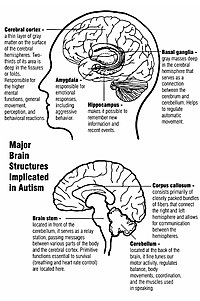
Photo from wikipedia
The aim of this study was to classify children with Autism Spectrum Disorder (ASD) according to Autism Classification System of Functioning: Social Communication (ACSF:SC) criteria, in order to investigate the… Click to show full abstract
The aim of this study was to classify children with Autism Spectrum Disorder (ASD) according to Autism Classification System of Functioning: Social Communication (ACSF:SC) criteria, in order to investigate the association between social communication ability, ASD severity, adaptive functioning, cognitive abilities and psychoeducational profile. The severity of social communication impairment was specified through Diagnostic and Statistical Manual of Mental Disorders‐5th edition (DSM‐5) and ACSF:SC tool. The ADOS‐2, Vineland‐II and PEP‐3 were administered to all participants. We found a positive correlation between DSM‐5 levels and ACSF:SC‐Typical Performance (r = 0.35; P = 0.007) and ACSF:SC‐Capacity (r = 0.31; P = 0.01) levels. Children included in the five levels of ACSF:SC (Typical Performance and Capacity) showed statistically significant differences in ADOS‐2 (Social Affect), Vineland‐II (Communication and Socialization), and PEP‐3 (Communication, motor skills, maladaptive behavior) scores. The results of this study indicate that ACSF:SC provide a better understanding of functional profile of children with ASD based on the social communication abilities. Children with greater severity of social communication showed more difficulty in adaptive behavior and psychoeducational profiles. In conclusion, the ACSF:SC could help clinicians and therapists not only to understand the strength and weakness of preschool children with ASD but also to devise specific treatment in order to promote their social integration. Autism Res 2017. © 2017 International Society for Autism Research, Wiley Periodicals, Inc. Autism Res 2017, 10: 1249–1258. © 2017 International Society for Autism Research, Wiley Periodicals, Inc.
Journal Title: Autism Research
Year Published: 2017
Link to full text (if available)
Share on Social Media: Sign Up to like & get
recommendations!